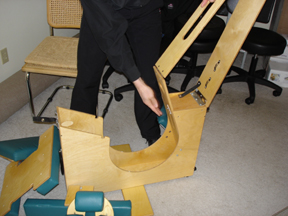Massages Everywhere
My first Atlantic column is out in the new July/August issue and available--but only for the next couple of days--here. Here's the opening:
When you step off a plane in Indianapolis, one of the first things you see—right next to the directions to baggage claim and ground transport—is a sign advertising massages, from the fifteen-minute "Fast Track" for $18 to the half-hour "Extended Stay" for $33. Travelers can find similar services at airports in Providence, Anchorage, Cedar Rapids, and Baltimore. The Seattle-based Massage Bar has expanded from Sea-Tac to airports serving Nashville, Newark, and Washington, D.C.
And you don't have to go to the airport. Car washes in Dallas and Austin offer chair massages while you wait. Tired shoppers can get them at the Fashion Show mall on the Vegas Strip, at Whole Foods Markets, and at many large bookstores. Massage breaks are regular features at business conventions and sporting events.
Once a specialized therapy for injured athletes, an indulgence for the idle rich, or a cover for prostitution, massage has become a legitimate and seemingly ubiquitous enterprise. Between August 2004 and July 2005, about 47 million American adults got at least one massage, up 2 million from the previous year, according to the American Massage Therapy Association's annual consumer survey.
 One of the most important factors in the spread of massages was the invention of the portable massage chair. I tracked down the inventor David Palmer, shown here. Here, from the article, is how he got started:
One of the most important factors in the spread of massages was the invention of the portable massage chair. I tracked down the inventor David Palmer, shown here. Here, from the article, is how he got started:
In 1982, he was running a San Francisco massage school and worried that not enough graduates were finding jobs. If massage was so great, why didn't more people want it?
The answer was pretty obvious: everything about the experience scared off potential clients. "If you want to make sure massage didn't make it into the mainstream," Palmer says, "make it as expensive, inconvenient, and scary as possible. Force people to go into a private room behind closed doors, take off all their clothes with a stranger, lie down on a table, get slathered with oil for an hour, and pay $70, $80, $90 for the privilege."
Massage needed a form that was cheap, quick, convenient, and fully clothed. Palmer developed an acupressure-based routine, or kata, that took just fifteen minutes and was done while the client sat on a drummer's stool. [Like the one Palmer is sittig on in the photo above--vp.] Although a chair massage might cost more per minute than a table massage, the price for the experience was much lower. The next step was to create a special chair to support the client's head, arms, and legs.
 The first massage chairs were made of wooden pieces that fit into a wooden carrying case and were assembled, often with some fanfare, onsite, as Palmer is demonstrating in the photo. The case and chair weighed 27 pounds, so it's not surprising that they were eventually replaced by lightweight, collapsible models.
The first massage chairs were made of wooden pieces that fit into a wooden carrying case and were assembled, often with some fanfare, onsite, as Palmer is demonstrating in the photo. The case and chair weighed 27 pounds, so it's not surprising that they were eventually replaced by lightweight, collapsible models.
My columns will be available to magazine subscribers in the archive on The Atlantic's great website. The Atlantic online archive is incredible, stretching back to the 19th century, and it alone is worth the price of a subscription.